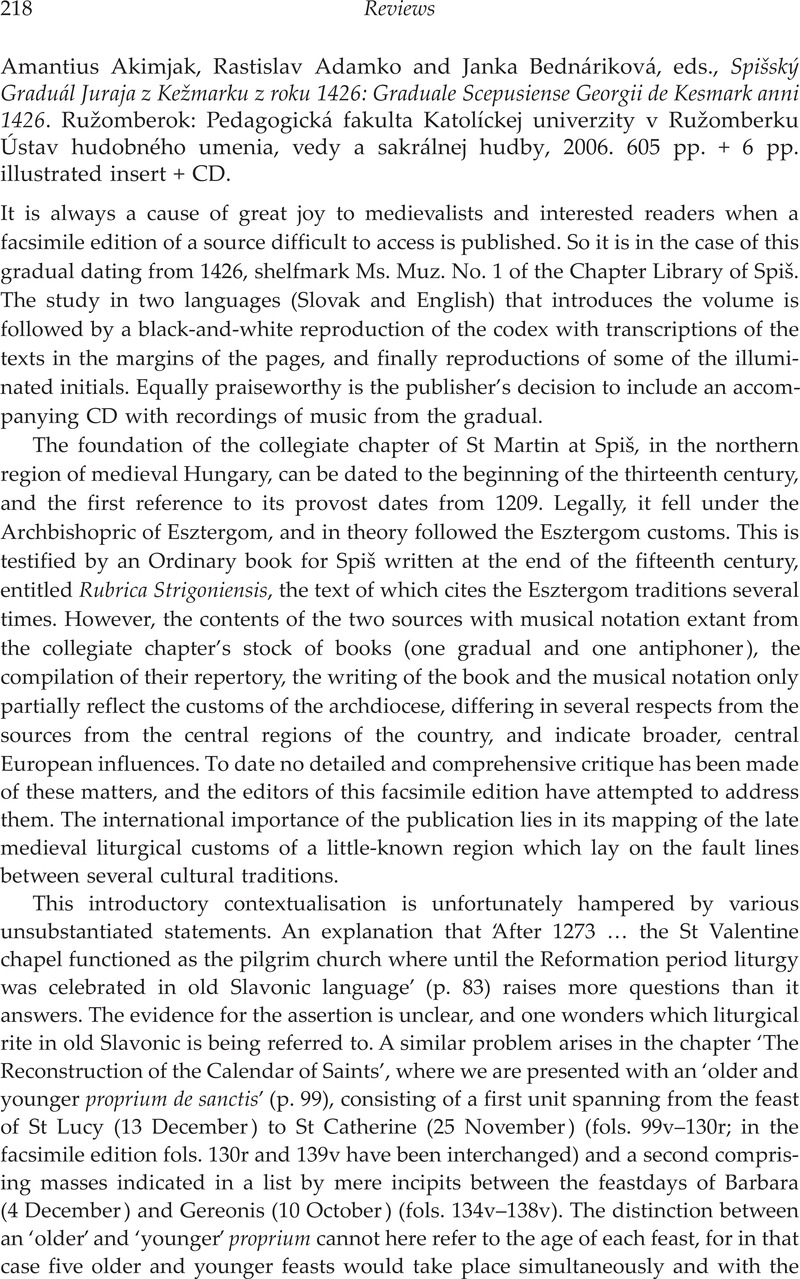No CrossRef data available.
Article contents
Amantius Akimjak, Rastislav Adamko and Janka Bednáriková, eds., Spišský Graduál Juraja z Kežmarku z roku 1426: Graduale Scepusiense Georgii de Kesmark anni 1426. Ružomberok: Pedagogická fakulta Katolíckej univerzity v Ružomberku Ústav hudobného umenia, vedy a sakrálnej hudby, 2006. 605 pp. + 6 pp. illustrated insert + CD.
Published online by Cambridge University Press: 17 September 2010
Abstract

- Type
- Reviews
- Information
- Copyright
- Copyright © Cambridge University Press 2010
References
1 See Kovács, Andrea, Corpus Antiphonalium Officii Ecclesiarum Centralis Europae, V/B: Esztergom / Strigonium (Sanctorale) (Budapest: MTA Zenetudományi Intézet, 2006Google Scholar ; hereinafter CAO-ECE V/B); also CAO-ECE VI/B: Kalocsa-Zagreb (Sanctorale) (2008).
2 H-Gc s.s., fol. 213; I-Rvat 8247, fol. 240.
3 A-GÜ I/34, fol. 351.
4 H-Bn MNy 1, fol. 82.
5 PL-Kk 45.
6 Graduals: PL-CZ s. s., fol. 315; PL-Kk 44, fol. I; missals: PL-Kk 3, fol. 160; PL-Kk 6, fol. 213; PL-Kk 8, fol. 311.
7 It is here referred to as an Antiphoner. See Zsuzsa Czagány, CAO-ECE III/B: Praha (Sanctorale, Commune Sanctorum) (2002).
8 CZ-Pn I.B.10, fol. 74 (31 December); CZ-Pn XII.A.21, fol. 116; CZ-Pn XIII.B.17, fol. 115v; CZ-Pn XIII.5c, sine fol.; H-Bn 93, fol. 94.
9 HR-Zu MR 29, fol. 259v; HR-Zu MR 120, fol. 266; RO-AJ R.II.46, fol. 234; TR-Itks 42, fol. 298r.
10 H-Bn 94, fol. 273r (oratia in the margin); H-Bn 214, fol. 216r (oratia in the margin); H-Bn 366, fol. 3v (in the calendar); H-Bn 395, fol. 6v (in the calendar); H-Bn 408, fol. 4v (in the calendar).
11 See CAO-ECE V/B: 23 April in twenty-one of twenty-eight sources; 6 November in twelve of twenty-four sources; however, with one exception every Esztergom codex includes the feast of the translation omitted in the Pauline and Spiš sources. CAO-ECE VI/B: this April feast appears in all Kalocsa-Zagreb codices: A-Gu 211, fol. 94r; A-GÜ I/34, fol. 231v; I-Rvat 8247, fol. 196. In medieval Hungary, the sequence for this feast, Corona sanctitatis, appeared only in Esztergom ritual books (12). The earliest source of this feast is HR-Zu MR 126, fol. 80.
12 Janka Szendrei, A ‘Mos Patriae’ kialakulása 1341 előtti hangjegyes forrásaink tükrében (The Formation of ‘Mos Patriae’ in the Light of the Notated Sources before 1341) (Budapest, 2005), 159–60.
13 Szendrei, A ‘Mos Patriae’, 160–1.
14 HR-Zu MR 126. fol. 76v.
15 For example, ‘on Ascension octave day’ (in fact, Sunday after Ascension), we are informed that the Spiš Gradual includes incipits of three alleluias, two of which are not in the codex, and none of which features in the sources selected for comparison (p. 119). In fact two of them are included both in the Kosice Gradual and in the Esztergom missal, and elsewhere, while the third listed here as Cognoverunt is better known correctly as Cum venerit. The chant Exultate Deo – Summite psalmum does not appear exclusively in Polish and Prague sources, as stated here, but is familiar from several Hungarian sources too, and the alleluia chants O pia regis filia and Sponsa veri Zachariae for the Feast of St Elisabeth can be documented from several regions of medieval Hungary, not only Prague and Poland respectively, as stated here.
16 See Janka Szendrei and Richard Rybarič, eds., Missale Notatum Strigoniense ante 1341 in Posonio, Musicalia Danubiana 1 (Budapest, 1982); TR-Itks 68; also H-Bn 215 (65 sequences), H-Bn 94 (68) and HR-Zu MR 133 (90 sequences).
17 The Futaki and the Transylvanian Graduals also include it: TR-Itks 68, fol. 292v; H-Bn Fol. lat. 3815, fol. 176v.
18 RO-Sb s.s., fol. 160v.




